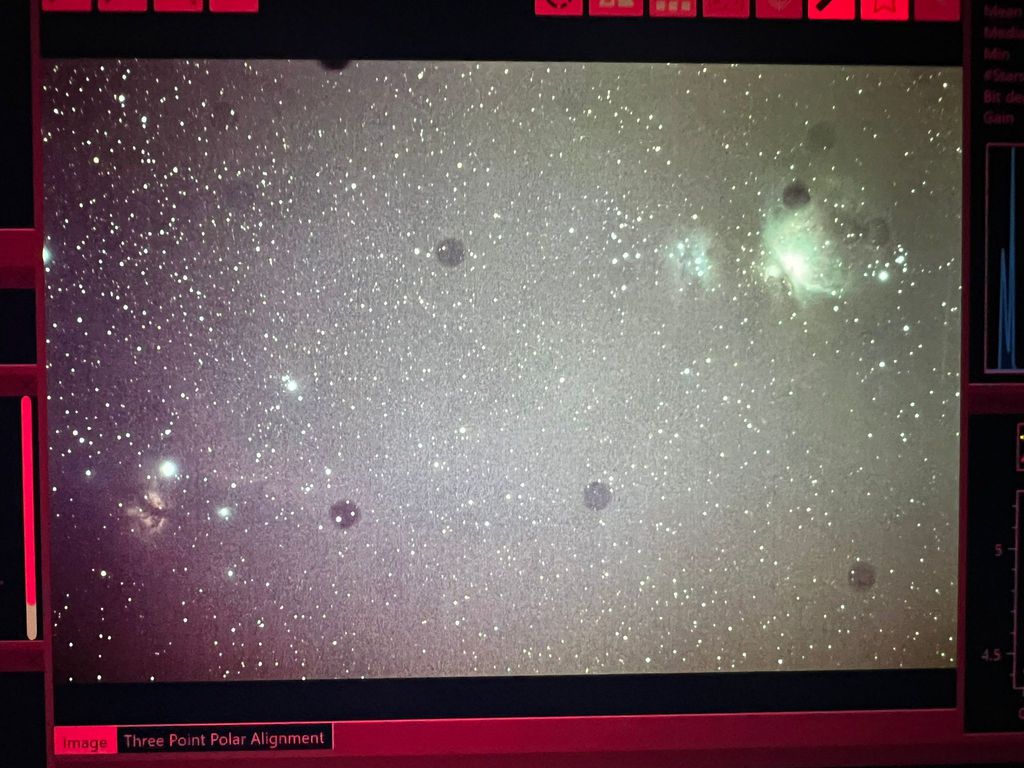Hi everyone I am new to the astrophotography world. The other day while i was capturing my light frames i noticed some strange spots. I don´t know if it is dust or if something is wrong with my set up. I would appreciate any advise about what it is and if i can remove it Thank u all in advance  |
You cannot like this item. Reason: "ANONYMOUS".
You cannot remove your like from this item.
Editing a post is only allowed within 24 hours after creating it.
You cannot Like this post because the topic is closed.
Copy the URL below to share a direct link to this post.
This post cannot be edited using the classic forums editor.
To edit this post, please enable the "New forums experience" in your settings.
That's dust on your sensor or sensor window.
|
You cannot like this item. Reason: "ANONYMOUS".
You cannot remove your like from this item.
Editing a post is only allowed within 24 hours after creating it.
You cannot Like this post because the topic is closed.
Copy the URL below to share a direct link to this post.
This post cannot be edited using the classic forums editor.
To edit this post, please enable the "New forums experience" in your settings.
As mentioned above it's dust motes. You need to take flats in order to remove them (and correct for many other things besides). Depending on what you are going to use for processing the raw images there will be the right procedure to follow for light frame calibration. Just google it up or ask here for more details.
|
You cannot like this item. Reason: "ANONYMOUS".
You cannot remove your like from this item.
Editing a post is only allowed within 24 hours after creating it.
You cannot Like this post because the topic is closed.
Copy the URL below to share a direct link to this post.
This post cannot be edited using the classic forums editor.
To edit this post, please enable the "New forums experience" in your settings.
Hi welcome to this hobby - hope you will have a great time!
Yes it is certainly dust - it is always a good idea to keep the camera sensor or the screen on it as clean as possibly - same as with daytime photography. Next step is taking flats, bias frames and dark frames and so on. When I started with astrophotography I skipped all these additional procedures until I noticed how important they are for the final image.
|
You cannot like this item. Reason: "ANONYMOUS".
You cannot remove your like from this item.
Editing a post is only allowed within 24 hours after creating it.
You cannot Like this post because the topic is closed.
Copy the URL below to share a direct link to this post.
This post cannot be edited using the classic forums editor.
To edit this post, please enable the "New forums experience" in your settings.
Thank u all for your advice
I will try to clean my sensor with the proper tools and the calibration frames.
|
You cannot like this item. Reason: "ANONYMOUS".
You cannot remove your like from this item.
Editing a post is only allowed within 24 hours after creating it.
You cannot Like this post because the topic is closed.
Copy the URL below to share a direct link to this post.
This post cannot be edited using the classic forums editor.
To edit this post, please enable the "New forums experience" in your settings.
One more tip: after cleaning, if you can keep your imaging train assembled it should prevent this happening again. Not always possible I know, but thought I'd mention.
CS.
|
You cannot like this item. Reason: "ANONYMOUS".
You cannot remove your like from this item.
Editing a post is only allowed within 24 hours after creating it.
You cannot Like this post because the topic is closed.
Copy the URL below to share a direct link to this post.
This post cannot be edited using the classic forums editor.
To edit this post, please enable the "New forums experience" in your settings.
Thank u all for your advice
I will try to clean my sensor with the proper tools and the calibration frames. If your camera's still attached to your telescope and you haven't moved it, you can still take flats if you want to try to salvage. Easiest is to point to the sky at dusk/dawn (away from lights and/or the moon) and take some short exposures so that the image histogram if about 50% (the image looks medium gray unstretched). If you want to do this, do it before cleaning the sensor so it records the dust. I also take a bunch of bias frames (shortest exposure frames with the telescope covered at a similar temp as you took the shot with). With just bias and flats, you should get rid of most of the issues. I generally don't take darks or dark flats since the thermal signal on the ASI2600 is insignificant even for 300 sec exposures.
|
You cannot like this item. Reason: "ANONYMOUS".
You cannot remove your like from this item.
Editing a post is only allowed within 24 hours after creating it.
You cannot Like this post because the topic is closed.
Copy the URL below to share a direct link to this post.
This post cannot be edited using the classic forums editor.
To edit this post, please enable the "New forums experience" in your settings.



